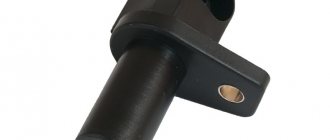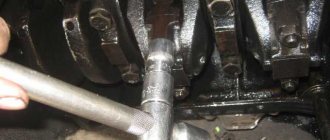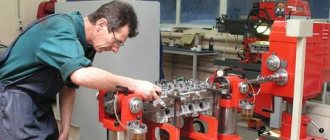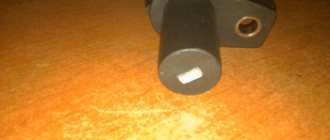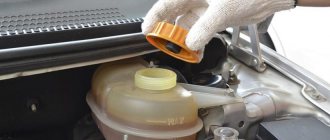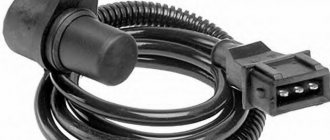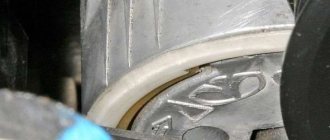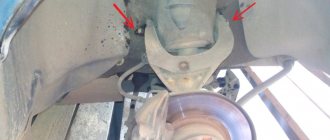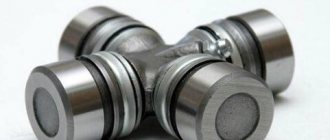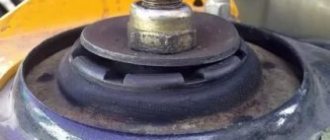Turned engine bearings: what to do
Often on numerous forums dedicated to automotive topics, you can read topics about knocking in the engine or cranked bearings.
This is an emergency situation in the internal combustion engine. When they say that the liner has rotated, this means that the plain bearings on the crankshaft and on the connecting rods have been torn out of their seats and have become unusable. This is a serious breakdown that happens quite often. Car enthusiasts see the reason in low-quality motor oils from an unknown manufacturer. But there are many more reasons, and they are not directly related to the lubricant and its quality. To prove this, there are many examples where main bearings fail if branded original oil is poured into the engine. Or vice versa - bearings operate for hundreds of thousands of kilometers on average quality oils. Let's figure out why the crankshaft liners rotate, what factors influence this, and what is the main reason for this phenomenon.
Causes of engine knocking
If immediate action is not taken, the knocking noise in the engine may intensify. In the systems of the gas distribution mechanism, cylinder-piston group and crank mechanism, knocking can occur:
- piston in cylinder;
- piston pins;
- camshaft in the block head;
- directly the crankshaft in the cylinder block;
- the so-called rocker arm, as well as the axis of the valve mechanism;
- valve and valve guide;
- valve and cylinder head (cylinder head).
If timing parts (chain or belt), made of hard and sufficiently durable materials, are worn out, the knocking noise can continue for a long time. The destruction of the softer elements that function in tandem with the metal bearings and liners will cause the sound to begin to intensify.
Difference between main and connecting rod bearings
You need to know that there are two types of liners. These are connecting rods and main ones. The first are located between the connecting rod and the crankshaft journal. The root element is similar to the first in its purpose. However, it is located where the crankshaft passes through the engine housing. The inserts vary in size. Dimensions depend on the type of internal combustion engine for which a specific part is manufactured. There are also special repair inserts. They are different from the original new ones installed in the engine. Repair inserts differ only in marks that are multiples of 0.25 mm. So, their sizes are approximately the following - 0.25 mm, 0.5 mm, 0.75 mm, 1 mm.
More details about the part
Liners are essentially sliding bearings, which are needed by the connecting rods that rotate the crankshaft, and individual parts of the shaft itself. Rotation is ensured by a mixture of air and fuel burning in the engine cylinders. Of course, the engine operates under heavy loads and strives to spin the crankshaft as much as possible. The problem of possible friction of parts is especially acute here, and the emergence of the so-called. dry (oil-free) friction can damage the engine very quickly. The solution is simple: ensure that a thin oil film is always present. It turns out that the crankshaft liners are only a kind of protection that maintains an oil film in friction areas. Ideally, the liners should fail for adequate reasons. Let us immediately note that the crankshaft liners are as follows:
- Indigenous . Such liners are placed between the shaft itself and the places where it passes through the engine housing;
- Connecting rods . They are installed between the connecting rods and journals of a car crankshaft.
As mentioned above, crankshaft bearings do not look like classic roller or ball bearings - they look like ordinary half rings. The fact is that ordinary bearings will not withstand the loads generated by the car’s power unit. Only some low-power motors have rolling bearings installed, while the most common are plain bearings. To summarize, the purpose of the crankshaft bearings is as follows:
- Ensure normal transmission of forces and moments that arise during operation of the power unit;
- Minimization of friction forces that arise at the contact points of the crankshaft, cylinder block supports, and connecting rods;
- Centering of parts, correct positioning;
- Oil distribution.
It is worth noting here that the geometry of the liners changes over time. original bearings installed at the automaker's factory are not always as replacements It is recommended to install liners of repair sizes , which are thicker. If non-repair bearings are installed on an old engine, the gap between the parts will be too large, which can result in knocking noises and intense wear of the crankshaft.
Reasons for rotating liners
So, the crankshaft is a part that operates in harsh conditions and has to withstand enormous loads in extreme temperatures. In order for the mechanism to be securely held on the axis and to ensure the correct operation of the entire crank mechanism, liners are needed. The journals on the shaft act as an internal race. Inserts - as external ones.
The internal combustion engine block has channels for supplying lubricant under pressure. Due to the oil film that envelops the liners, the crankshaft can rotate. Why do car owners encounter situations where the crankshaft liners have turned in the engine? There are several possible reasons. Let's look at them below.
Mechanical wear
The first reason why the main and connecting rod bearings are replaced when repairing an engine is wear. Parts wear out due to mechanical loads. Many people try to save their earbuds, but it is useless. Physics is involved here, and physical processes cannot work any other way. Wear and tear is inevitable. The anti-friction layer on the liner wears off over time. This leads to free movement of the crankshaft. Backlashes appear. As a result, the oil pressure decreases, quite significantly. On most engines that are highly reliable, if the liner turns, this indicates their wear.
Signs of bearing wear
Entry of foreign bodies. Foreign matter can get into the engine most of the time we repair it, and we don't see when something accidentally gets into the crankcase. This usually gets dirt, sand, and debris. Dirt will quickly spread throughout the engine and cause great damage to it. Sand particles will scratch in all rubbing areas of the engine, and the engine can quickly fail.
Elimination methods.
If dirt gets on the surface of the liner, scratches form; if it gets scratched, it is necessary to drain the oil and change it. Check oil and air filters for integrity. Flush the engine with flushing fluid to remove all dirt particles.
Corrosive abrasion
There is corrosion wear on the back surface of the liner. In this case, there may be several reasons.
1 When repairing the engine, the mounting bolts were loosely tightened
2 The engine often ran at high speeds
3 Foreign bodies are on the bearing surface of the liners
4 The wrong size earbuds are installed
corrosive abrasion
Methods for eliminating the causes of problems are also varied
1 Tighten the bolts with a manometric wrench according to the required force.
2 Try to take care of the engine and not squeeze the last juices out of it at high speeds.
3 Always check the cleanliness of the liner assembly.
4 Use the appropriate size earbuds.
Metal fatigue
Signs. If the metal is fatigued, the detachment of metal particles in the middle of the liner, where the maximum load occurs, will be clearly visible on the liner. With long-term use the same thing will happen.
metal fatigue
There are several reasons.
1 Uneven load on the bearings when the engine is running.
2 The inserts do not meet the manufacturer's requirements (defective).
3 Engine troubles and uneven operation.
4 Engine vibration.
Elimination method
1 Check the visual condition of the liners.
2 Check the crankshaft, take measurements, replace the bearings.
3 Eliminate the causes of uneven engine operation.
4 Measure the compression in the engine cylinders.
WATCH THE VIDEO
Rotating the crankshaft connecting rod bearings
This is also one of the popular faults. Many car owners have faced this problem. But not everyone knows about the reasons. Let's figure out what happens to the element. The connecting rod bearing plate is quite thin.
It is installed on a special seat. The outer walls on the half rings have special protrusions, which, even in a non-run-in and undeveloped engine, rest against the front part of the cylinder block. At a certain point, the seat simply cannot hold the connecting rod bearing. The result is a typical situation - the liner has turned. The plate not only rotates, but also sticks to the crankshaft journal. In this case, the engine stalls and will not start again.
Causes of connecting rod bearing failures
Internal combustion engine repair specialists see several reasons why plain bearings rotate. This is often due to excessively thick oil, which contains metal particles. Lubricant with chips has an abrasive effect on the liners. Often there is a complete lack of oil. This especially affects cars with worn oil scraper rings. Some of the lubricant simply goes “down the pipe.” As a result, the liner rotated and the engine was sent for repair. The bearing caps may not be tightened sufficiently together. And finally, one more reason. This is too thin oil. Such products are especially harmful for motors operating under high loads.
Preference violation
If the liners have turned, this could be the reason. This will not happen in production cars assembled at the factory by qualified specialists. But if the engine has already been repaired, then, most likely, the selection of liners was made incorrectly and the tension was broken.
When the motor is running, the liners experience increased friction torque. This moment tends to rotate the liner. And due to the reduced force that holds the part in place, the risk of turning increases significantly. Under the influence of an uneven load, a weak fit of the friction bearing causes the liner to vibrate. The lubricating film is also damaged. As a result, the part rotates, and the retaining threshold is unable to prevent this.
How to determine a breakdown
When turning the main bearings, the crankshaft and cylinder block immediately fail. If the connecting rod bearings rotate, the connecting rod itself, the spindle, and the cylinder block will fail. As a result, the car owner can only benefit from a major engine repair. This failure can be determined. There are some signs of loose liners. One of them is a characteristic metallic knock throughout the engine.
It does not stop even at idle, and with increasing load it knocks even more intensely. Another sign is low oil pressure. If the engine is cold, then there may be no sounds. If the situation is hopeless, the engine will stall, and it can only be revived by repair.
Prevention methods
As mentioned above, partial failure of the liners entails increased wear of the engine, and in particular, its lubrication system. Therefore, in order to prevent such a situation, it makes sense to carry out periodic preventive measures. So, first of all, you need to use the engine oil recommended by the car manufacturer . This is especially true for its viscosity. You should not buy very cheap oil, since there is a high probability that it will contain abrasive particles that negatively affect the engine as a whole, and the liners in particular.
It is also worth periodically checking engine parts, their condition, geometry, and cleanliness. When performing repair work, you must always ensure that no dirt gets into the engine and/or lubrication system (oil). There is a so-called “golden rule” for mechanics, which states that a gap of 0.03 mm more is better than a gap of 0.01 mm less. In this case, the liner is guaranteed not to fail, not melt or rattle. Keep your car's engine in good condition and it will serve you for many years.
It is better not to wait until the light on the dashboard lights up indicating low oil pressure. Ideally, you should periodically check the pressure value yourself or at a car service center. After all, the oiler light turns on (that is, the emergency sensor is triggered) only in extreme cases, when the pressure has dropped to critical. It is better to avoid this, especially on engines with significant mileage.
Conclusion
It is necessary to periodically check the condition of the liners, since these seemingly insignificant details can lead to major problems with the engine oil system, thereby significantly reducing its service life. And the sooner the breakdown can be identified and repaired, the lower the costs the car owner will have to face in the future to carry out engine repairs. The replacement procedure can be carried out either independently or at a service station. However, if you decide to carry out the repair yourself, then you must be 100% sure that you will be able to complete the job, since replacement involves a large amount of both dismantling and installation work.
A vehicle engine is a complex unit in its design, consisting of thousands of different parts. In order for the internal combustion engine system to operate in a balanced manner, all elements of the unit must function properly. In this article we will talk about liners for crankshaft repair: what is their purpose, what is the marking and how to replace components.
Repair and consequences
Typical situation - the liners have turned. What to do? The problem can be solved in different ways, depending on the nature of the damage. In some cases, you can get by by replacing the liners with grinding the crankshaft. In difficult situations, repairs will be significantly more expensive.
If the connecting rod bearing has turned, this is not a serious problem in modern engines. But this does not apply to the indigenous. It often happens that a damaged liner is simply replaced, and the motor continues to work. Experts do not recommend this approach. The service life of the connecting rod-crankshaft journal pair restored in this way can be greatly reduced. A much more acceptable option is to replace the connecting rod with which the problem occurred. Also, if the liners are turned (including VAZ-2172), the lock on the connecting rod will definitely break. It would be more optimal to bore the crankshaft to the next repair size and completely replace the liners and connecting rods. It is imperative to grind the shaft after turning it.
A little about the selection of liners
Selecting bearings on your own is a rather risky business, since it will be difficult to choose a part that does not quite fit the crankshaft of your car. The fact is that it is important for a potential buyer to take into account not only the compatibility of the spare part with the car, but also the condition of some of its components. In this case we are talking about the crankshaft , which will also have to be ground. So, you often cannot do without turning to an expert who will disassemble the engine and carry out diagnostics. It is likely that you will have to install repair liners of great thickness. Such details can be searched using the following parameters:
- Vehicle data;
- VIN code;
- Code for a suitable insert.
The easiest way to search is in online store catalogs. There, a car enthusiast will be able, for example, to find original bearings and, based on them, select repair ones. If the old liners have simply worn out due to long-term use and significant loads, there is a possibility that troubleshooting the crankshaft will not be necessary. From this it follows that it will be somewhat easier to select suitable earbuds.
If you want to do as much work as possible yourself, then first you will have to determine the clearance indicator. To do this, you need a torque wrench and a special calibration wire. If the gap is large, this indicates the need to bore the shaft and further install repair liners . Work with the shaft can only be entrusted to professionals. The size of suitable inserts can be determined with a micrometer. You can also find information useful for finding earbuds in technical manuals.
Why does the connecting rod bearings or crankshaft bearings turn?
The connecting rod or crankshaft bearings are plain bearings, which are additionally supplied with engine oil from the engine lubrication system. This solution allows loaded parts to move freely and easily, while achieving a pairing of loaded elements in which there are no gaps or backlashes. Such sliding bearings should be understood as a high-strength steel sheet of a special shape, on which a special anti-friction coating is applied.
Rotating connecting rod bearings or crankshaft bearings is a serious problem that must be corrected immediately. Most often, the driver becomes aware of a problem due to the appearance of a distinct, characteristic connecting rod knock or knock of the engine crankshaft. Further operation of the internal combustion engine in which the liner has been rotated is highly not recommended, since breakdowns of this kind cause significant damage not only to the associated parts, but also to other components of the power unit. Next we will talk about what to do if the connecting rod bearing has turned, what the cause and consequences of such a breakdown could be.
Why does the liners rotate?
The liners in the engine are installed in special installation locations (liner bed). Installation requires special fixation, since the liners have holes in their body, which allows engine oil to be supplied to them. The indicated holes must clearly coincide with the holes that are drilled in the parts themselves for the passage of lubricant. Also, fixing the liner is necessary taking into account the fact that during engine operation friction occurs on the surfaces of the mating elements.
Taking into account the above information, it becomes clear that if the connecting rod bearing has turned, the reason may be as follows:
As is known, friction occurs as a result of the sliding of two bodies relative to each other in the presence of a certain load. The total magnitude of the friction force will depend on the magnitude of the load on the rubbing pair, as well as on the friction coefficient. In order to reduce the friction force in the manufacture of parts, special anti-friction materials are used that have a low coefficient of friction.
As for the liner, anti-friction material is applied to its surface. The crankshaft performs a rotational movement in relation to the liners; at the junction of the liner and the crankshaft, a friction force arises, which tends to rotate the liners in relation to their installation locations. To protect against rotation and displacement, the liner is held in place by a special tendril. Also, during installation, the liners themselves are inserted with a certain interference, the value of which is calculated by the designers of a particular internal combustion engine.
It becomes clear that excessive friction or insufficiently reliable fixation (weak tension) are the main reasons why it is not possible to keep the liner in its seat. Note that during engine manufacturing at the factory, insufficient tension of the liners during the assembly of the internal combustion engine is extremely rare. More often, problems with main or connecting rod bearings appear after the engine has been repaired. In other words, incorrect selection of repair liners and other defects that do not allow the required tension to be achieved lead to turning. Since the crankshaft is subjected to uneven loads, the loosened liners begin to vibrate, the oil film on their surface is destroyed, and the liner can “get caught.” In such a situation, turning is inevitable, since the fixing tendril is simply not able to withstand the moment of turning on the liner itself.
As already mentioned, another reason for cranking of the engine bearings is an excessive friction torque, that is, the design operating conditions of the plain bearings themselves are violated. Normal operation of the liners involves so-called fluid friction, that is, the surface of the liner and the crankshaft journal are separated by an oil film. This avoids direct contact of loaded parts, provides the necessary lubrication and cooling, and minimizes friction.
It is quite obvious that if the oil film is not thick enough or breaks through, the coefficient of friction will begin to increase. The operation of mating parts that are under constant load under such conditions will mean that the cranking torque has increased. To put it simply, the greater the friction force, the more the risk of crankshaft liners turning under such increased loads increases.
An increase in loads in the liner-crankshaft pair leads to a decrease in the thickness of the oil film or to a complete rupture (dry friction). In parallel with the increase in friction force, increased heat release occurs, and local overheating occurs in the friction area. As heating increases, the temperature stability of the oil is disrupted, the thickness of the oil film decreases even more, and the liner can stick to the surface of the crankshaft journal.
It should also be added that the thickness of the oil film between the mating parts directly depends on the speed at which these parts move relative to each other (hydrodynamic friction). The faster the parts move, the more intensely the oil enters the gap that is present between the rubbing elements. It turns out that a thicker oil wedge film is created compared to the same film at a lower speed of movement of the mating parts. In this case, it is necessary to take into account the fact that an increase in the speed of movement of parts increases the friction force, and the heating from such friction also increases. This means that the temperature of the engine oil begins to rise, the lubricant thins out, and the film thickness becomes thinner.
The friction force is also influenced by the precision with which the surfaces of the mating parts are made, the degree of roughness of these surfaces, etc. If, for example, the surface of the liner or journal is uneven, then zones will arise in which almost dry friction will occur or the parts will contact under conditions of insufficient oil film thickness. At the same time, such dry friction zones can also occur in cases where mechanical particles are present in the engine oil, that is, the oil is contaminated.
Consequences of rotating the bearings
Let's start with the fact that turning the connecting rod bearings of the engine when a breakdown is detected in a timely manner is a less serious problem compared to turning the crankshaft main bearings. If the problem is detected late, then the consequences for the internal combustion engine may be different. It happens that after cranking the connecting rod bearing, the engine may require an expensive overhaul.
A common situation is when a cranked connecting rod bearing is simply replaced with a new one and the engine continues to run. Note that it is not recommended to do this due to the fact that the service life of the connecting rod-crankshaft journal coupled pair repaired in this way can be greatly reduced (by 60-70%). A more acceptable option is considered to be the approach of changing the connecting rod in which the liner was turned. Also, the connecting rod often needs to be replaced due to the fact that as a result of turning the liner, the connecting rod lock breaks. The optimal method of repair is considered to be boring the crankshaft and replacing the bearings/rods.
Grinding the crankshaft after turning the liner is usually a necessary operation, since scuffs appear on the journal. After disassembling the engine, the crankshaft must be measured, after which it is bored, taking into account the subsequent installation of new bearings of repair size. This is the only way to achieve the required condition of the surfaces and the correct tension of the liner after installation.
How to install liners on the crankshaft - procedure
In most cases, replacement of liners is carried out at a service station, but if desired, any driver who has repair skills and knows how to use the tool can easily try to carry out this operation on his own. To do this, you need to do the following steps sequentially:
- First of all, it is important to check the gap between the liner and the crankshaft. To do this, a calibrated plastic wire is placed on the desired neck. After this, the cover with the liner is installed and tightened with the required force (approximately 51 N m (Newton per meter), this value can be measured by tightening the unit under test with a torque wrench). After removing the cover, the gap is determined by the degree of flattening of the wire . To evaluate this parameter, there is a nominal gap for each make of car, and if the wire indicates that the gap is larger, then a repair liner will be required.
- After checking the clearances on all connecting rod journals, it is necessary to remove the connecting rods, dismantle the crankshaft and send it to the boring machine. Grinding is carried out on a special machine (centripetal), which, of course, not everyone has. Therefore, it is better to do this with a master. After boring, you need to select the crankshaft liners, here again a micrometer will help and further fitting with measuring the gap.
- When the size of the liners is finally selected, the crankshaft is installed in the reverse order. Its elements must be placed in their seats and the main bearing caps must be screwed on.
- Next, you need to decide how to install the liners on the crankshaft and install the connecting rods in their places. To do this, they are lubricated with engine oil, their caps are screwed on, so that direct installation takes a minimum of time, not to mention preparation. It is important to assemble the crankshaft with the same clutch and flywheel installed in the engine before repair.
We must remember that the crankshaft is one of the expensive parts in any car. In addition, it bears the heaviest load. Therefore, it is necessary to take all measures to extend its service life. In this matter, timely boring of the crankshaft plays a decisive role. After this procedure, all necks become perfectly smooth and ready for further work. It is this factor that determines the quality of the overhaul.
What's the result?
Taking into account the above information, we can conclude that the appearance of knocking in the engine is a reason to immediately stop using the vehicle. It should also be taken into account that the condition of the liners is greatly influenced by the operating temperature of the power unit. In other words, engine overheating can lead to cranking of the connecting rod or main bearings, engine jamming, etc. In this case, the engine may become completely unusable, as the crankshaft bed breaks, the crankshaft itself, the cylinder block, etc. fail.
As for engine oil, it is necessary to use only those fuels and lubricants that meet all the requirements and necessary approvals of the power unit manufacturer. Also, the oil and oil filter must be changed promptly to prevent dirt and mechanical particles from getting into the lubricant. The lubrication system itself also deserves increased attention, since decreased performance or malfunctions can lead to oil starvation, which significantly increases the risk of bearings turning.
Finally, we add that the gasoline engine needs to be warmed up after a cold start, then you need to drive without loads until the power plant reaches operating temperatures. In the case of a diesel engine, the engine warms up while driving; it is not recommended to sharply load the unit until it is completely warmed up. It should also be remembered that both a new engine and a motor after repair need to be run in, since loaded pairs and mating elements need to be ground in.
Source
Signs and causes of wear
Now let's move directly to the types of damage that contribute to wear of the liners and their failure.
Entry of foreign bodies
Signs . A sign of foreign bodies or dirt ingress is a situation where local damage to the working surface on the liner occurs. In some cases, there may also be some (less) damage on the back of the part. Typically, debris or dirt on the surface of the liner is the root cause of further wear. Therefore, it is necessary to identify this malfunction as early as possible. Otherwise, the wear will spread further and a significant surface area will be damaged, up to 100%.
Causes . As stated above, this situation is caused by dirt or debris getting between the liner and its support. This also causes the formation of places with high oil pressure, in which the oil film is destroyed. In turn, this leads to destruction of the surface of the liner during its operation.
Elimination methods . First of all, it is necessary to check the bearing surfaces of the liner and shaft for damage. If they exist, they must be eliminated. After this, you need to make sure that the surfaces are clean. This is especially true when new liners are installed.
Mud erosion
Signs . A sign of mud erosion is the presence of burrs or inclusions of dirt. Sometimes both. In particularly advanced cases, mud erosion can move to areas near the oil holes.
Causes . The reason in this case is low-quality oil, which contains dirt impurities or abrasive materials.
Elimination . It is necessary to check the operation of all moving engine parts. The lubrication system must be checked especially carefully. It also makes sense to check the oil and air purification system (primarily the filters). When assembling the engine, you must prevent dirt from getting into it. After all this, you must definitely change the oil to a new one.
Corrosive abrasion
Signs . We are talking about the presence of corrosive abrasion on the rear steel surface of the liner. As a rule, traces of corrosion are located closer to the connection of the halves of the liner body.
Causes . In this case, there may be several reasons. Among them:
- Reduced pressing force. This leads to slight movements of the liner body relative to the surface of their support.
- The mounting bolts were loosely tightened during installation.
- There are foreign bodies on the contact surfaces of the liner support.
- Prolonged engine operation at high speeds (especially if this occurs frequently).
- Using inserts with inappropriate dimensions (width).
Elimination . According to the different causes of the problem, the resolution methods may also be different. In particular:
- Tighten the mounting bolts to the torque recommended by the vehicle manufacturer.
- Inspect the seat diameter of the liner support.
- Check the cleanliness of the contacting surfaces between the liner and the support.
- Use the insert of the prescribed size (width).
- Try not to use the engine at high speeds for a long time.
Metal fatigue
Signs . Fatigue can be caused not only by prolonged use of the liner, but also by excessive load on it. Signs of its failure will be a situation when particles of material are literally torn out of its body, especially in places of significant load.
Causes . There may also be several of them:
- Using unsuitable or poor quality earbuds. This leads to their significant overload.
- The main load during operation falls on the edges of the liners.
- Incomplete combustion of fuel in the combustion chamber.
- Incorrect car engine tuning.
